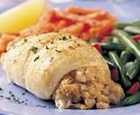|
British Entree Baked Stuffed Haddock Lovely white fish stuffed with savory bread crumb dressing. So British.
Rinse and pat fillets dry. Combine lemon juice with next 4 ingredient and pour over fish. Cover and marinate 2 hours. Preheat oven to 425. For stuffing, combine first 4 ingredients. Blend bread crumb mixture with softened butter. Drain fish fillets from marinade, turn skin side up,* and spread with filling. Starting with the tail end, roll up and fasten with a toothpick. Arrange rolls, seam-side down, in a well-buttered baking pan and dot with additional butter. Bake 25 minutes, basting occasionally with pan juices. * This seems counter-intuitive. But the skin shrinks during cooking and, if left on the outside, can pull the rolls apart. |
Tips & Glossary Clotted Cream: a thick yellowish cream made from unpasturized cow's milk. You can make your own, although it's hard to find unpasturized cream in the U.S. Still, you'll find 3 recipes under Scones. All use pasturized cream; try to avoid "ultra" pasturized. Ploughman's Lunch: sounds romantic, like a peasant dish from medieval times, but it's a marketing gimmick from the 1970's! It's become a popular lunch in Britain now: a piece of bread, hunk of cheese, with onion, gherkin, and an apple. Our Ploughman's Soup is a take-off on that name. Roux: (“roo”), paste-like mixture of melted butter and flour, into which liquid is gradually added. Used as a thickening agent for soups and all classic French sauces. Basic Roux: melt 1 part butter and add 1 part flour. Stir continuously till it becomes paste-like. Slowly add whatever liquid your recipe calls for. Tea Time: Afternoon tea became fashionable in the mid-1600's. A light snack with sandwiches and sweets, it's served from 3-5 in a sitting room. High tea, is a light meal served from 5-6 in a dining room. ("High" because the dining table is higher than the low ones in a sitting room.) Yorkshire Pudding: from the northern county of Yorkshire, originating in the early 1700s when flour was more readily available. A pancake like batter is spooned into the drippings of a roast as it cooks. Eaten alongside the roast or as a separate course.
|

